| |
108-Letter-Long Buddhist Code Wraps
Around the Tanakh Nine Times
Starting with a Buddhist ELS with a skip of 101,012, Nathan Jacobi, Ph.D., discovered a 108-letter-long extended code that makes clear sense to Buddhists. It wraps around the entire Tanakh a record 9.03 times. It is the fourth longest code BCD has discovered to date [see 10 longest codes BCD has previously found.].
Because of the presence of several highly improbable features, this code defies chance as a rational explanation. Consider these aspects:
How likely is it:
- That any extended code discovered around the original search term Buddhist would be more than 50 letters long? Close to nil. More than 100 letters long? Much, much closer to nil.
- That such a code, with each letter of it being 101,012 letters apart, could be real, and have coherent content from a well-known point of view, given the likelihood that there have been copying errors in the progression of versions of the Hebrew Bible that have existed over the centuries? Close to nil.
- That a code that wraps around the entire Hebrew Bible over nine times, could be real? Close to nil.
- That the content of the seven sentences of this code would make almost immediate sense to Buddhists? Close to nil.
- That the length of this code (108 letters) coincides with one of the most significant numbers in Buddhism and Hinduism? About 2%?
- That an unusually high number of the letters of this code appear in contexts regarding topics important to Buddhism? Probably one in a 1,000 or less.
- That all of the above could be true about a single code? About as close to an impossibility as one could get . . . unless it had been intentionally encoded.
Buddhist Code #14
I will predict that he will provide a basis, and the sect will be a shoulder to the echo of their nation. Will you, the speaker, be believed by them in the name of God? Shatter its root, Buddhist. Where from came he who implored me? From whom came the witness of the thundering and hot echo? Only the brother has felt the flow of the vat and the son of God, the mountain. I will command him to provide a hand to the sect as she blunders.
The number 108 is very significant in Buddhism. According to Swamij.com, there are generally 108 beads on a mala, the string of beads that are used during mantra counting. A mantra is a word or sound used to focus the person's concentration. That word or sound would then be repeated 108 times. Why 108 times? The Swamij.com website lists over 40 reasons that the number 108 is special, several of which are:
- 108 is the product of the numbers 1 to the 1st power, 2 to the 2nd power, and 3 to the 3rd power.
- There are said to be 108 earthly desires in mortals, 108 lies that humans tell, and 108 delusions or forms of ignorance.
- There are 54 letters in the Sanskrit alphabet, each of which has a masculine and feminine form, creating 108 letters.
- In Hinduism, there are 108 deities, each with 108 names.
- In Buddhism, a bell is rung 108 times to celebrate the new year, and there are 108 virtues to cultivate and 108 defilements to avoid.
We will break up our comments between the different phrases and sentences of this lengthy code.
- I will predict that he will provide a basis, and the sect will be a shoulder to the echo of their nation.
Buddhism came to Tibet from India, and it incorporated the local B�n tradition (i.e., the shamanistic and animistic tradition of the Himalayas prior to Buddhism's rise to prominence in the 7th century). Buddhism incorporated many of these elements while transforming them into more universal concepts of loving-kindness, compassion. Rituals that were shamanistic were changed into practices for training the mind. Tibetans have become less and less Buddhist, and their practices are often performed out of tradition and not as a genuine practice and discipline of the mind.
Many Tibetans couldn't read, so when the Chinese came and scattered the best monks from Tibet around the world, a basis for teaching Buddhism throughout the world was provided.
There are five different sects in Tibetan Buddhism. As Tibetan Buddhists teach in other nations, there is a need for them to shed their uniquely national traditions (i.e., the echo of their nation).
- Will you, the speaker, be believed by them in the name of God?
This next portion of the code could be addressed to these same Tibetan teachers, pointing out the likelihood that they won't be believed because there is so much that is distinctly Tibetan in what these monks teach.
- Shatter its root, Buddhist.
Many people of other religions and faiths have the perception that Buddhists worship idols and that Buddhism is a pagan religion. It would seem that the idea of shattering that concept is described in the second sentence of this code. Shatter its root, Buddhist, could be a call to the Buddhist to make clear that the perception others have of Buddhism is incorrect, and that it needs to be shattered.
- Where from came he who implored me? From whom came the witness of the thundering and hot echo?
The speaker could be asking, "What is the source of these opinions." The thundering and the hot echo may refer to the source, the biggest, deepest source of the grounding of all beings, which in Buddhism is the Dharmakaya.
- Only the brother has felt the flow of the vat and the son of God, the mountain.
The first portion of this code is mysterious, but the second half lends itself to this Buddhist point of view. The son of God is one who takes the word of Buddha and applies it to become a better being. A mountain can be a symbol of the solidity and strength of God.
- I will command him to provide a hand to the sect as she blunders.
How easy it is to blunder in communicating Buddhist beliefs and practices to a culture that is completely different. This code suggests that someone or something will be provided to help with that process. In addition, the different schools of Buddhism are called sects and are just an echo of the culture from which they came.
Context
In examining the context of the surface text that the code passes through, we found a number of passages about offerings/sacrifices, death, priests, prophecy, wisdom, and peace. All of these topics are important components of Buddhism (Buddhist priests are called monks). We have color-coded the table accordingly.
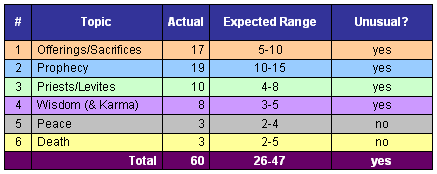
The "expected range" of verses regarding each topic is based on approximate estimates of the percentage of all Old Testament verses that would pertain to each topic, times 108 letters.
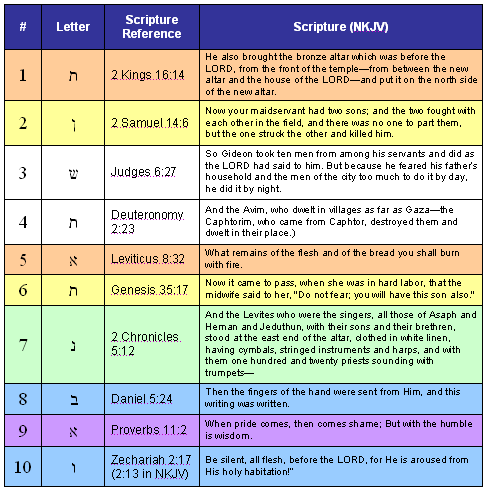
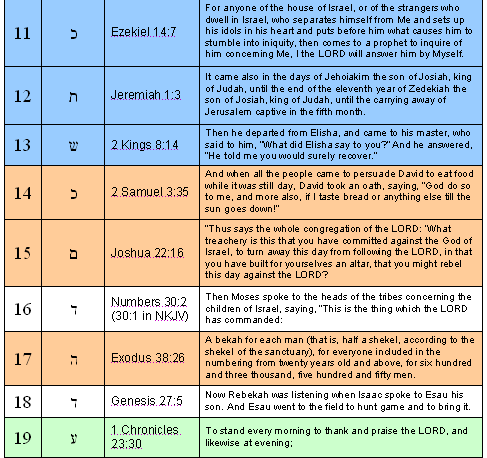
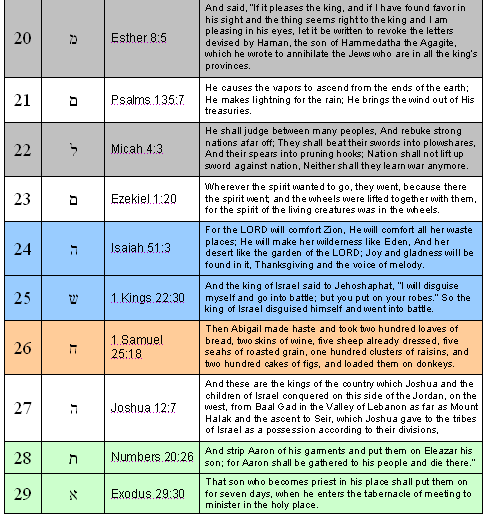

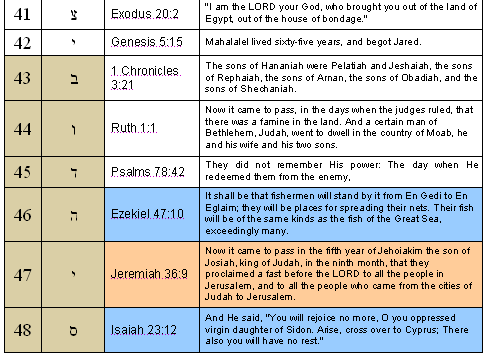



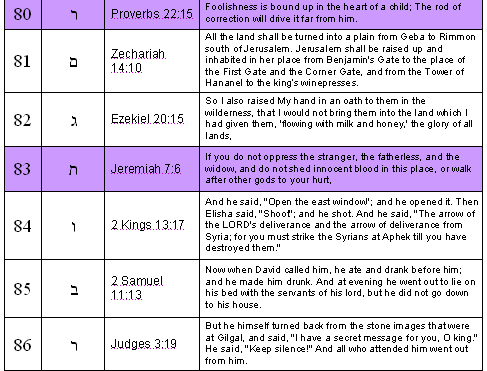

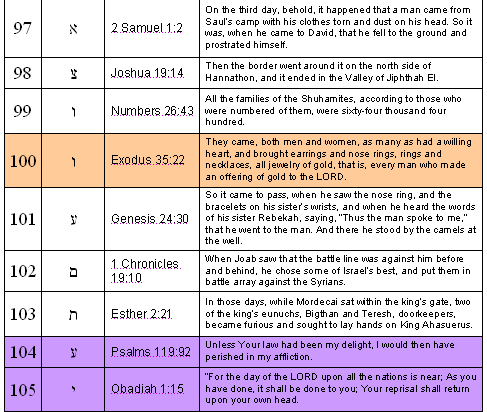

Return to Dramatic Buddhist Codes Discovered
Continue to Buddhism and Buddhist Tables
|
|


 
Bombshell examines two massive, recently discovered clusters of codes in the Hebrew Old Testament. To read more about Bombshell, click here, or click below to order from Amazon today!
 
|







